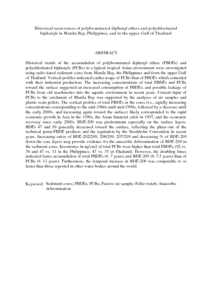Citation
Kwan, Charita S. and Takada, Hideshige and Boonyatumanond, Ruchaya and Kato, Yoshihisa and Mizukawa, Kaoruko and Ito, Maki and Dung, Le Quang and Zakaria, Mohamad Pauzi and Santiago, Evangeline C.
(2014)
Historical occurrences of polybrominated diphenyl ethers and polychlorinated biphenyls in Manila Bay, Philippines, and in the upper Gulf of Thailand.
Science of the Total Environment, 470-471.
pp. 427-437.
ISSN 0048-9697; ESSN: 1879-1026
Abstract
Historical trends of the accumulation of polybrominated diphenyl ethers (PBDEs) and polychlorinated biphenyls (PCBs) in a typical tropical Asian environment were investigated using radio-dated sediment cores from Manila Bay, the Philippines and from the upper Gulf of Thailand. Vertical profiles indicated earlier usage of PCBs than of PBDEs which coincided with their industrial production. The increasing concentrations of total PBDEs and PCBs toward the surface suggested an increased consumption of PBDEs; and possible leakage of PCBs from old machineries into the aquatic environment in recent years. Current input of PCBs to the catchment of Manila Bay was supported by the analyses of air samples and plastic resin pellets. The vertical profiles of total PBDEs in the cores (i.e., rapidly increasing concentrations corresponding to the mid-1980s until mid-1990s, followed by a decrease until the early 2000s, and increasing again toward the surface) likely corresponded to the rapid economic growth in Asia in the 1990s, the Asian financial crisis in 1997, and the economic recovery since early 2000s. BDE-209 was predominant especially on the surface layers. BDEs 47 and 99 generally decreased toward the surface, reflecting the phase-out of the technical penta-PBDE products and the regulation by the Stockholm Convention in recent years. Increasing ratios of BDE-202/209, 206/209, 207/209 and decreasing % of BDE-209 down the core layers may provide evidence for the anaerobic debromination of BDE-209 in the sediment cores. Inventories in ng/cm2 of total PCBs were higher than total PBDEs (92 vs. 34 and 47 vs. 11 in the Philippines; 47 vs. 33 in Thailand). However, the doubling times indicated faster accumulation of total PBDEs (6–7 years) and BDE-209 (6–7.5 years) than of PCBs (8–11 years). Furthermore, the temporal increase in BDE-209 was comparable to or faster than those reported in other water bodies around the world.
Download File
![[img]](http://psasir.upm.edu.my/37872/1.hassmallThumbnailVersion/Historical%20occurrences%20of%20polybrominated%20diphenyl%20ethers%20and%20polychlorinated%20biphenyls%20in%20Manila%20Bay.pdf)  Preview |
|
PDF (Abstract)
Historical occurrences of polybrominated diphenyl ethers and polychlorinated biphenyls in Manila Bay.pdf
Download (184kB)
| Preview
|
|
Additional Metadata
Actions (login required)
 |
View Item |

